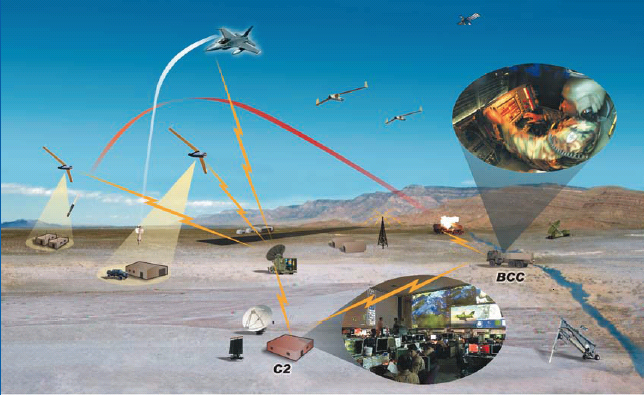Semantic Designs Enables Boeing Unmanned Aerial Vehicles
Semantic Designs, Inc. (SD) participated in a live-fire demonstration using unmanned aerial vehicles (UAVs) to provide targeting information. The Boeing UAVs used Boldstroke avionics software, automatically reengineered by custom SD tools, to help manage the UAV flight and data collection processes.
The demonstration used UAVs on autonomous patrol, scanning the ground using video cameras, computing GPS coordinates of the camera view, and relaying video and coordinates to ground command and control centers (C2). Decisions to destroy a detected site caused coordinate information to be forward to offensive military weapons such as an F-16 with JDAM, or ground based missile launchers (BCC) such as HIMARS with ATACMS. Using the coordinate information, the offensive weapons can accurately hit the designated target. This shows the effectiveness of autonoumous UAVs in managing a battle site. All of this battle management is enabled by software.
Boeing's very successful BoldStroke avionics software is a component software system, in which each component manages a part of the aircraft (radar, nosegear, canopy, ...). Configuring an aircraft for a class of missions is accomplished by choosing the appropriate BoldStroke components for that aircraft and mission pair. Components are distributed across multiple computers in a single airframe. Boldstroke is used across Boeing's entire line of military aircraft, and has thousands of components. Each Boldstroke component consists of a sets of C++ classes which implement the component functionality; these classes use underlying Boldstroke communication protocols to signal events and move data among the distributed components.

Autonomous Unmanned Aerial Vehicles (UAVs) spotting targets using Video
Learn more about this Boeing UAV capability demonstration
A key problem in modern avionics systems is managing the scarce information-carrying resources in an aircraft. The legacy BoldStroke components were designed before video cameras were a practical possibility in aircraft, and were able to manage with the limited bandwidth available in internal airframe busses with a legacy real time system without any special techniques. Video's enormous bandwidth would overwhelm the internal busses and prevent the components from operating properly.
DARPA and Boeing teamed to find a solution in the PCES program (Program Composition for Embedded Systems), to develop innovative technologies to improve the development of distributed, real-time embedded (DRE) systems for the purpose of detection, tracking, and engaging time critical targets (TCTs). The team chose to use CORBA/RT to replace the existing realtime OS, and ensure that each component (including video components) were gauranteed an appropriate share of precious bandwidth.
A key difficulty was the legacy Boldstoke components were wired to the legacy OS and legacy communication protocols. Manual conversion of components to use CORBA/RT would require man-months for each component. The cost of converting the large component base to use CORBA/RT threatened to kill the technology. Semantic Designs used its DMS® Software Reengineering ToolkitTM and existing C++ front end to develop a highly automated conversion tool that converted legacy BoldStroke components into CORBA/RT compatible components, replacing legacy OS calls with equivalent CORBA/RT calls, and automatically rearchitecting the components to provide CORBA compliant interface facades. The automated tool can convert BoldStroke components to CORBA/RT compatibility in a matter of minutes, with some manual postprocessing. Use of such a tool enables the conversion of legacy software systems in a form more effective for future weapons platforms.
Semantic Designs is a recognized leader in the development of automated software tools to address complex problems with large, critical software systems. Customers include Fortune 200 Enterprises, government agencies and prime government contractors. Semantic Designs allies with large defense contractors in unclassified and secret programs and delivers effective results for software migrations and modernizations. Semantic Designs also partners with leading integrators worldwide to meet enterprise customers' demanding requirements. Founded in 1996, Semantic Designs is a privately held corporation headquartered in Austin, Texas.
Press Contact:
Sales
+1-512-250-1018 x161
[email protected]
For specific modernization needs, contact [email protected].
